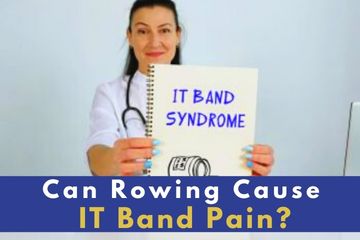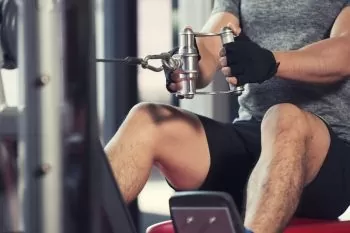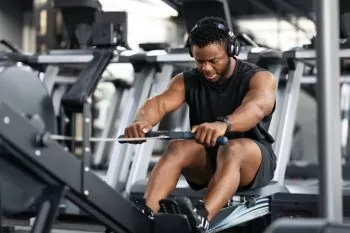
Got a pain in your… thigh?
If you’ve ever had IT band problems, you know how that localized pain can be pretty excruciating.
You’ll see a lot of long-distance runners with this problem, and if you’re one of them, and you’ve switched to rowing, you aren’t alone.
Sports medicine abounds with injury prevention ideas and flexibility exercises, but this remains one of the most common injuries among sports fans, including rowers.
If you are reading this, you either have iliotibial band syndrome, or you’ve had it in the past and you want to avoid a repeat performance.
You’ve come to the right place! Today, I want to address that annoying problem that so many people go to physical therapy for.
I’m going to tell you how even rowing athletes develop this painful condition, how you can avoid it, and how to stop it from ever returning.
Ready? Keep reading because we’ve got a lot of ground to cover.
A Short Anatomy Course on IT Band Syndrome

Iliotibial band friction syndrome is such a long word that it is shortened to IT band syndrome or ITB friction syndrome.
No matter what you call it, this condition hurts like heck!
This issue causes pain between the hip and the knee joint, but most people feel the pain near the outside top edge of the knee.
This band is a strong, thick cable of tissue that runs down the outside of your thigh. It extends from your hip bones to the top of your shinbone.
When you move your leg, this band moves along the outer edge of the thighbone, keeping the leg stable.
However, with repeated movement, the band can develop inflammation and irritate other nearby tissue and muscles. This is one of the most common overuse injuries that athletes suffer from, right next to a knee injury.
Now that you know what iliotibial band friction syndrome is, let’s talk about ways to prevent it and how to stop that pain.
Can Rowing Cause IT Band Syndrome?
Technically, yes, it can, but this is more common for marathon runners or professional rowers who spend hours each day rowing.
The name “syndrome” means that there are usually several symptoms or causes for this injury, so you may be doing another form of exercise or work that is adding to the problem, but you only notice the pain after you row.

When the IT band becomes tight or short, it can cause inflammation. This is why warming up before you row and stretching either after your rowing session or taking up stretching exercise classes like yoga are so important!
IT band pain, like wrist pain, is one of the most common rowing injuries, but it can be prevented in many instances.
How Do I Know If I Have Knee Pain or IT Band Pain?
Patellofemoral stress syndrome (kneecap) pain is also one of the most common rowing injuries. Knee injuries, in general, can happen to anyone at any age, but after 50 years of use, it is not uncommon to have some type of kneecap pain or knee injury even if you don’t row or run.

Knee pain differs from iliotibial band pain in that when you’re rowing, you will feel pain in the front of the kneecap. This is sometimes accompanied by a clicking sensation or crunching sound as you bend forward.
Iliotibial band pain will be felt on the outside of the knee, on the outermost portion of the thigh but directly above the knee joint itself.
If you aren’t sure where the pain is, you should consult with a sports medicine doctor.
How Do I Stop My IT Band from Hurting?
This is the big question, right? I know because when I’m in pain, sometimes I don’t care what is hurting exactly, I just want the pain to stop!

The most common methods of reducing IT band pain include:
- The RICE method (Rest, Ice, Compression, Elevation). This is not what most people want to hear, but it remains one of the best ways to heal inflammation issues.
- You should also stop all forms of leg exercises, even walking, until the pain has subsided.
- Other pain remedies include hot baths, hot wraps, over-the-counter heat gels such as Voltaren.
- Time heals most injuries, so give your body the time it needs to repair itself. Most people find that 6 weeks of rest is sufficient.
- You can also take over-the-counter pain medications and anti-inflammatory medications, such as ibuprofen or curcumin supplements.
You should always speak to your doctor before taking any supplements, even over-the-counter pain medication to ensure that there is no interaction with other prescription drugs you may be taking.
If the pain persists for more than 4 weeks with no improvement, see your doctor or a physical therapist.
How Do I Prevent Rowing Injuries like IT Band Syndrome?

There are several ways that you can do to prevent further injuries or prevent problems such as IT band pain from showing its face again.
- Work on improving lateral hip strength. Some sports medicine studies found that those with weak hip muscles had a muscular imbalance that made them more susceptible to both knee injuries and IT band pain.
- Be more conscious of your knee position. Letting your knees fall out to the sides or letting them stay close together can lead to band pain and even a stress fracture. Keep your knees apart but pointed straight ahead during all the rowing strokes.
- Don’t overdo it. Now I understand that this is hard to judge, but I would say that if you’re rowing more than 2 hours a day or practicing intense training every day without a break, you are overdoing it. Overuse injuries, even in cross-training or other types of training activities is a recipe for injury, sooner or later. It’s crucial that you give your body time to rest and recover.
- Work on your weakness. If you know that you have a weak part (ankles, knees, back) focus on making those stronger or more flexible (depending on what you need) rather than work on rowing faster or longer. Once you’ve strengthened your weak area, THEN you can focus on the other aspects of rowing.
- Stretching, stretching, and more stretching. I always encourage rowers to do some yoga or other types of stretching classes at least two days per week. You would be amazed at the number of painful body parts that seem to heal themselves simply by stretching. If you have a sit-down job, your body needs stretching and deep breathing classes more than you can imagine.
- Foam rolling. While you can’t stretch the IT band itself, you can stretch the muscles that it is attached to, which will keep the band looser. Foam rolling is a terrific way to stretch those muscles.
- Leg Support. You might also try one of the many brands of leg supports that prevent the IT band from becoming irritated. Cho-Pat is the most well-known name and some people swear by this band for stabilizing the leg.
Always be aware of your form while rowing. I’ve seen rowers who had their toes pointed inward, which kept their knees pointed towards each other.
I’ve also seen rowers who pointed their feet out, which caused the opposite problem.
Be aware of your technique when rowing but perhaps most importantly, give your body time to rest. If you start to feel pain, stop! I know some people say that you should “work through the pain”, but I’ve never seen anyone benefit from that mantra.
Let your body rest, stretch both before and after you row, practice good form, and you should be in the clear.
Check Out Our Top Machines for IT Band Issues!
What Exercise Can I Do and Which Should I Avoid with an IT Band Injury?
I completely understand that, even when you’re injured, you don’t want to stop exercising entirely.
Since an IT band problem is such a common rowing injury, I’ve actually seen people put the injured leg on a skateboard so it could roll on the floor and the person kept on rowing!
Exercises You Can Do
If you don’t want to try that, or if you’ve got pain in both legs, you can still do some of the following exercises:
- Any exercise that doesn’t involve the legs, including weight lifting, resistance bands, chin ups, even swimming if it doesn’t bother your legs. (Try swimming with just your arms and let your legs just hang in the water).
- Yoga and Pilates. Just be sure that you aren’t bending or stretching the injured leg
- Water aerobics
- Seated ellipticals. You can do just your arms or let your injured leg just hang off to the side
- Sit on the floor in front of a stationary bicycle and use your arms to work the pedals
- Kettlebells or medicine balls. Be sure to sit down so you don’t put added weight on your legs
- Speed bags. Again, you want to avoid putting weight on your leg so try to punch the bag while sitting
- Kayaking or canoeing
- Chair dancing or chair exercises using weights
You can do almost anything you like as long as it doesn’t involve putting a lot of weight on that leg or bending the knee. No, picking up a box of donuts and lifting them to your face does NOT count as exercise!
Exercises You Should Avoid
If you feel pain, STOP!
AVOID THE FOLLOWING:
- Running, spin bikes, or bicycle riding
- Walking (if you can walk slowly without pain, you might be OK, but most doctors advise against it)
- Any resistance bands or weightlifting that involves the legs
- Squats or lunges
- Jump ropes or any jumping activity
- Box jumping
- Leg extensions
- Donkey kicks
Pretty much anything that involves bending your knees or putting a great deal of pressure on your leg should be avoided.
Click Here to See My Favorite Interactive Rower!
The Bottom Line

Discovering what makes your IT band hurt is a big step towards stopping the pain.
Most people end up taking a multi-step approach towards eliminating pain, healing, and making modifications to avoid the injury again.
If all your efforts have not stopped the pain, or if you continue to reinjure the IT band, seek out your doctor or physical therapist for advice.
With a little effort and a little rest, most people are back in the rowing saddle within a few weeks.
Stay safe and healthy, friends. Happy rowing!
Written by Petra Amara – RowingCrazy.com
CEO & Founder of RowingCrazy, National Rower, Coxswain Womens Eight Team, Rowing Coach & Writer
Petra is a Mother of two and owner of Rowingcrazy.com. Petra lives and breathes rowing, she also has a passion for writing which lead her to start RowingCrazy.com to share her rowing experience and expertise with others.





